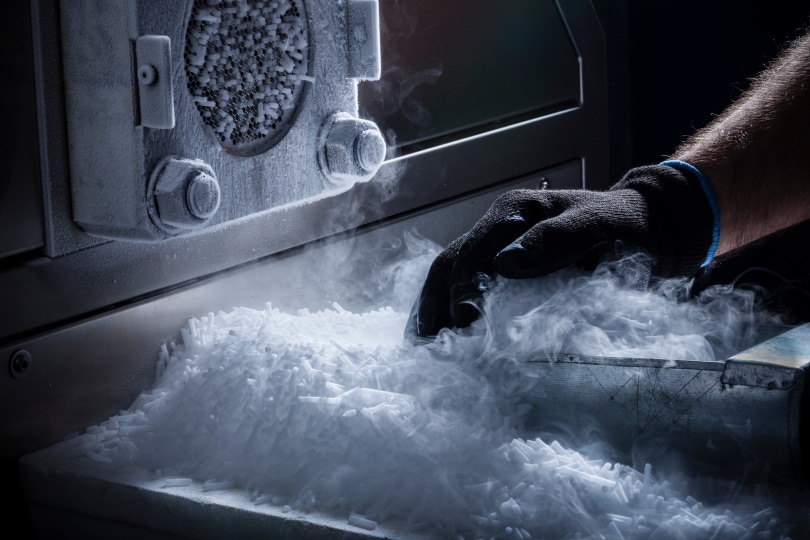How to Safely Dispose of Dry Ice: What You Need to Know!
-
- Last updated:


Dry ice is solidified carbon dioxide that has been frozen down to -109.3 degrees Fahrenheit. This extra chilly substance can freeze food and help out fog machines, making it available at grocery stores and home centers. Since this substance has the ability to flash freeze foods, it is often used as a freezer backup if the power or fridge goes out.
Despite the common usage of dry ice, it poses serious health risks. Simply touching it to your bare skin can cause frostbite in less than a minute. Additionally, dry ice can cause explosions if it evaporates in a contained area.
Because of the safety concerns regarding dry ice, you can’t just throw it away in your regular garbage can. Instead, you need to dispose of it safely, though most people don’t know how. Here is a quick overview of how to safely handle and dispose of dry ice.

What is Dry Ice?

Dry ice is simply the solid form of carbon dioxide. It can only be created when exposed to temperatures below -109.2 degrees Fahrenheit, which happens to be the earths atmospheric pressure. Anything warmer causes dry ice to sublimate, the technical term for evaporate.
Because dry ice requires extremely cold temperatures, touching dry ice is a serious no-go. Just touching your bare skin to it for a few seconds can cause frostbite.
As the dry ice evaporates, the carbon dioxide is normally not dangerous unless confined in a tight area. Evaporating dry ice in a confined area leads to an explosion from gas buildup. If evaporated in an open area, though, the carbon dioxide will generally be safe and leave no residue in the way that ice would leave a puddle of water after melting.

Safety Tips When Handling Dry Ice
Given the potential for frostbite or explosions, you need to handle dry ice safely. Whether you are using it to freeze food, start your fog machine, or dispose of it, you need to take special precautions to keep yourself safe.
Don’t Touch Dry Ice with Your Bare Skin
Even though we have already said that you shouldn’t touch dry ice to your bare skin, we’re going to say it again. We can’t overstate the importance of avoiding exposure to dry ice. Always make sure you are wearing proper safety gear and long sleeves when handling this substance.
Don’t Store More Than 10 Pounds in Your Fridge
When you are using dry ice, do not store more than 10 pounds in your fridge. Storing more than 10 pounds can potentially cause excess carbon dioxide to build up, leading to an explosion. Additionally, don’t store dry ice in small coolers or mini fridges. For the same reason as mentioned above, storing dry ice in small compartments will cause explosions.
Don’t Transport Dry Ice Without Ventilation

Similarly, make sure that your transportation has proper ventilation. Assuming that you will transport the dry ice in a car, make sure to roll down the windows or turn off the air recirculation option in the car. Try to transport the dry ice in under 15 minutes.
Don’t Dispose of Dry Ice Improperly
Once you have finished using your dry ice, do not dispose of it improperly. Do not dump it near trash cans, garbage shoots, or anywhere else with poor ventilation. This will cause it to explode.
To make disposable a bit more complicated, do not dump dry ice in open spaces that are also public areas. If other people or pets frequent the area, the dry ice could be ingested, leading to a number of serious health risks.

How to Dispose of Dry Ice
Since you can’t just toss dry ice down the garbage chute or trash can, you need to dispose of it properly. Here’s how:
What You’ll Need
- Dry ice
- Protective wear
- Open area
- Styrofoam or plastic container with lid
1. Safety First
Before disposing of dry ice, you need to put your safety first. Make sure you are wearing proper clothes to prevent contact with the substance. Long sleeves, close toed shoes, and insulated gloves are absolutely necessary.
2. Pick a Well-Ventilated Area

To dispose of dry ice, just let it evaporate. Select a well-ventilated area so not to cause any explosion. Also, select an area that is not public access to avoid exposing animals and other people to the substance.
Your backyard or fire escape will likely be the best options. Just make sure that your pets or children do not go outside while it is evaporating. Cool, clear days are the best to dispose of the dry ice, but evaporation will happen regardless of the weather.
3. Set Up
Once you know where you want to let the dry ice evaporate, get the substance from your cooler or fridge. If you wrapped newspaper pages around the dry ice during storage, remove them and set them aside, preferably in a plastic bag. Do not throw them away yet.
Place the dry ice within a Styrofoam or plastic container. Make sure that the container has a lid. Put the lid over the container, but do not secure it completely. Instead, leave the lid slightly ajar to allow carbon dioxide to escape.
4. Let It Evaporate
Now, take the container of dry ice to your intended evaporation area. Set the container on a flat surface so it does not tip over. Leave the container outside until all of the dry ice has evaporated. No solids or messes will remain. 5 to 10 pounds of dry ice normally takes around 24 hours to fully evaporate.
As it the dry ice evaporates, stay clear of the area as much as possible. Exposing yourself to too much carbon dioxide can cause headaches, nausea, or vomiting.
5. Clean Up
Once the dry ice has fully evaporated, dispose of the container, the gloves you used, wrapping newspaper, or any other material that came in contact with the dry ice. Take it to a local waste collection site. Make sure that it is disposed of as a hazardous waste product.
You may need to check out your local environmental services website to find out what areas near you accept hazardous waste products.

Conclusion
Because of the potential hazards that come with handling and disposing of dry ice, you can’t just throw it away in your garbage can. Although dry ice does require special disposal, disposing of the substance is really easy.
Dispose of dry ice by letting it evaporate in a well-ventilated area, free of people and animals. Also, make sure to dispose of any items that came in direct contact with the dry ice as hazardous waste products.
See Also:
- HOW TO EASILY GET GORILLA GLUE OFF YOUR SKIN
- HOW TO REMOVE A BROKEN BOLT OR SCREW (QUICKLY & EASILY)
Featured Image Credit: Yossawat fangseing, Shutterstock
Contents

